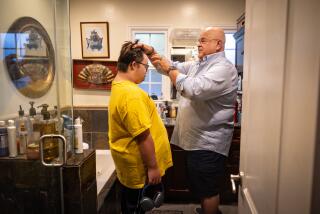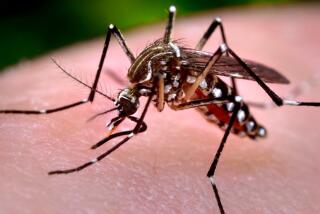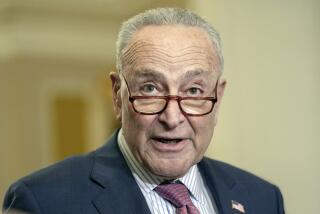$138 Million More Sought for AIDS : Health Service Wants to Expand 5 ‘Major Priority Areas’
- Share via
WASHINGTON — Federal health officials, saying that the number of AIDS cases they expect to develop by 1991 makes it “very clear that research and prevention efforts must be intensified,” have asked for an increase of $138 million over the President’s fiscal 1987 budget request of $213 million.
The Public Health Service, in a confidential memorandum to Health and Human Services Secretary Otis R. Bowen that was given to The Times on Sunday by Rep. Henry A. Waxman (D-Los Angeles), has requested that the new money be used to expand five “major priority areas.” These include health education and risk reduction programs, experimental treatment, vaccine development, surveillance and research into co-factors associated with acquired immune deficiency syndrome.
AIDS Cut Proposed
Neither Bowen nor the Office of Management and Budget has yet responded to the June 23 memo, written by Dr. Donald Ian MacDonald, then the acting assistant secretary for health. In February, the Reagan Administration proposed a reduction of $31 million in AIDS spending for fiscal 1987.
However, the House, moving on its own last week, approved fiscal 1987 appropriations for AIDS activities that were virtually identical to the Public Health Service request. The Senate has not yet acted.
The House action last week was typical of Capitol Hill behavior on AIDS financing. In recent years, lawmakers, responding to the pleas of researchers, consistently have appropriated more money than the Reagan Administration has requested.
Congress ‘Acts on It’
“Unfortunately, this is how AIDS budgets have been constructed over the years,” said Waxman, who chairs the House Energy and Commerce subcommittee on health. “The scientists make recommendations. The Administration ignores them. And the Congress, through informal--never formal--requests, receives the advice and acts on it.”
The health service said that the expansion of its programs would require $351 million, an increase of $138 million over the President’s $213 million budget request for fiscal 1987, which begins Oct. 1.
“We request that the . . . budget be amended to add these funds without offset against other PHS programs,” the memo said.
The service has proposed $47 million--the largest chunk of the increase--for education, saying that “in the absence of a vaccine and an effective treatment” this “vital activity” is currently “our most powerful tool to prevent and control the spread of AIDS.”
Includes Voluntary Testing
The memo described a series of major new education initiatives that include voluntary testing for exposure to the AIDS virus, “counseling and partner referral for at-risk populations, school health education programs and intensive outreach efforts to reduce . . . transmission among intravenous drug users.”
The service also has asked for an additional $14 million for research into co-factors involved in the development of the disease.
“The factors that determine the expression and progression of disease in an individual are largely unknown,” the memo said. “Recent developments, particularly those that relate to the mechanism of disease in the central nervous system, require expanded research.”
Other Research Proposed
The memo added: “Also, research studies on the role that may be played by other factors, including drugs, alcohol and genetics, are proposed to further understand this disease and its progression. Such information is essential to the development of effective treatment.”
In the area of expanded drug treatment programs, the PHS has suggested an increase of $29 million to establish “new drug discovery groups,” the development of quality control systems to assess treatment evaluation units, “the development of new methods to measure the amount of infectious AIDS virus in patients,” and several new government studies.
For surveillance, the agency asked for an additional $23 million to continue studying patterns of transmission--including increased research on drug users, heterosexuals and children--and to further clarify “differences in infection and illness rates among infected groups.”
Statistics ‘Troubling’
The PHS document, calling the statistics “indeed troubling,” cited the 1991 projections it released in June. It predicted a total caseload of 270,000 Americans by the end of the next five years, with 179,000 deaths. In 1991 alone, 145,000 people will “be ill and seeking treatment,” and 54,000 of them will die, the memo said.
“At this point, we estimate that 1 to 1.5 million Americans are infected with the AIDS virus,” MacDonald wrote in the memo.
“We anticipate that some increase will occur in the percentage of cases in the risk group we have called ‘heterosexual contacts,’ ” the memo continued. “We also expect to see AIDS spreading geographically and occurring much more widely outside of the New York City and San Francisco areas.”
In this country, AIDS, which destroys the body’s immune system, has primarily struck male homosexuals and bisexuals, intravenous drug users and their sexual partners. It is transmitted through intimate sexual contact and through the sharing of unsterilized hypodermic needles.
Thus far, there have been 23,115 cases in the United States, with 12,640 deaths.
More to Read
Sign up for Essential California
The most important California stories and recommendations in your inbox every morning.
You may occasionally receive promotional content from the Los Angeles Times.










